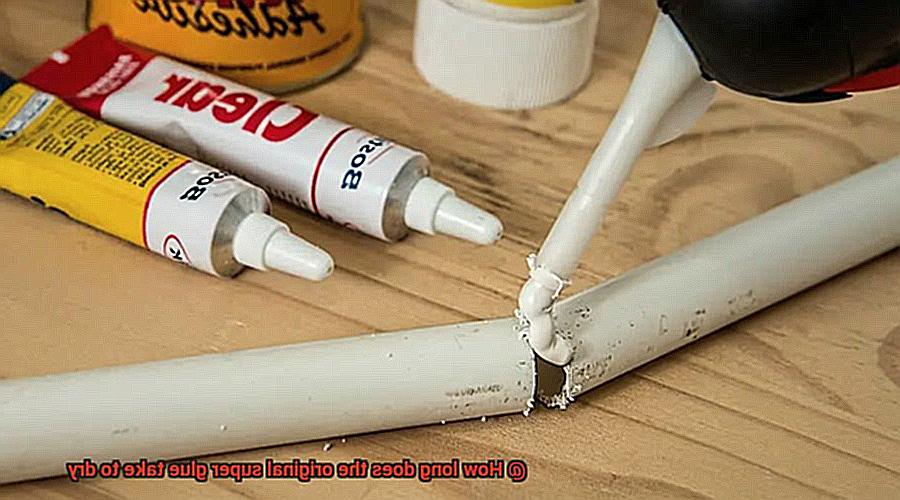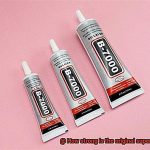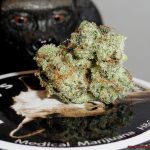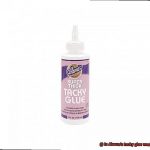Welcome to the world of super glue, where a few drops can work wonders and fix just about anything in a flash.
Whether you’re a DIY enthusiast or just someone who occasionally needs to patch things up, chances are you’ve come across the trusty sidekick known as original super glue. But have you ever wondered how long it takes for this magical adhesive to dry?
Well, get ready because we’re about to dive into the realm of rapid bonding. In this blog post, we’ll uncover the secrets behind the drying process of original super glue.
So sit back, relax, and prepare to be glued to your screen as we take you on a journey into the drying times of this legendary adhesive.
Factors Affecting Drying Time
Contents
- 1 Factors Affecting Drying Time
- 2 Average Drying Time of Super Glue
- 3 Preparing the Surfaces for Glue Application
- 4 Temperature and Humidity Effects on Drying Time
- 5 Applying the Right Amount of Super Glue
- 6 Holding the Bonded Surfaces Firmly Together
- 7 Curing Process of Super Glue
- 8 Accidental Contact with Skin or Eyes
- 9 Conclusion
Super glue is a versatile adhesive that has become an indispensable tool for quick repairs and bonding tasks. Its rapid drying time sets it apart from other adhesives, allowing for efficient and effective bonding. But have you ever wondered what factors contribute to the drying time of super glue? In this article, we will delve into the key factors that influence the drying time of original super glue, providing valuable insights to ensure successful bonding.
Type of Super Glue:
The type of super glue being used is the first factor that affects drying time. Different brands and formulations have varying drying times. It is crucial to consult the manufacturer’s instructions to determine the specific drying time for the super glue you are using.
Temperature and Humidity:
Temperature and humidity play significant roles in the drying time of super glue. Generally, super glue dries faster in warmer temperatures and lower humidity levels. High humidity can slow down the drying process, while colder temperatures may extend the drying time. Consider these factors when using super glue to create optimal drying conditions.
Surface Type:
The type of surface being bonded also impacts drying time. Porous surfaces such as wood or fabric may absorb the glue, resulting in longer drying times. Non-porous surfaces like glass or metal allow for faster drying as the glue does not get absorbed into the material.
Amount of Glue Applied:
The amount of glue applied affects drying time as well. Applying a thin layer of glue usually allows for quicker drying compared to applying a thick layer. Excessive amounts of glue can take longer to dry and may not bond as effectively.
Ventilation:
Proper ventilation is essential for the drying process of super glue. Good airflow helps evaporate moisture content in the glue, facilitating faster drying. Working in a well-ventilated area or using fans can help speed up the drying process.
Quality of Super Glue:
The quality of the super glue also affects its drying time. Higher-quality glues often have faster drying times compared to lower-quality ones. Opt for reputable brands known for their quick-drying properties.
Application Technique:
The technique used to apply super glue can impact drying time. Applying the glue evenly and in a thin layer helps speed up the drying process. Additionally, ensuring that the surfaces being bonded are clean and free from any residue or moisture contributes to faster drying.
Understanding the factors that influence the drying time of original super glue is crucial for achieving successful bonding results. Temperature, humidity, surface type, amount of glue applied, ventilation, quality, and application techniques all play significant roles in determining how quickly super glue dries.
By considering these factors and following the manufacturer’s instructions, you can create optimal drying conditions and achieve strong bonds in no time. Remember to exercise caution when using super glue and seek immediate medical attention if accidental contact with skin or eyes occurs.
Average Drying Time of Super Glue
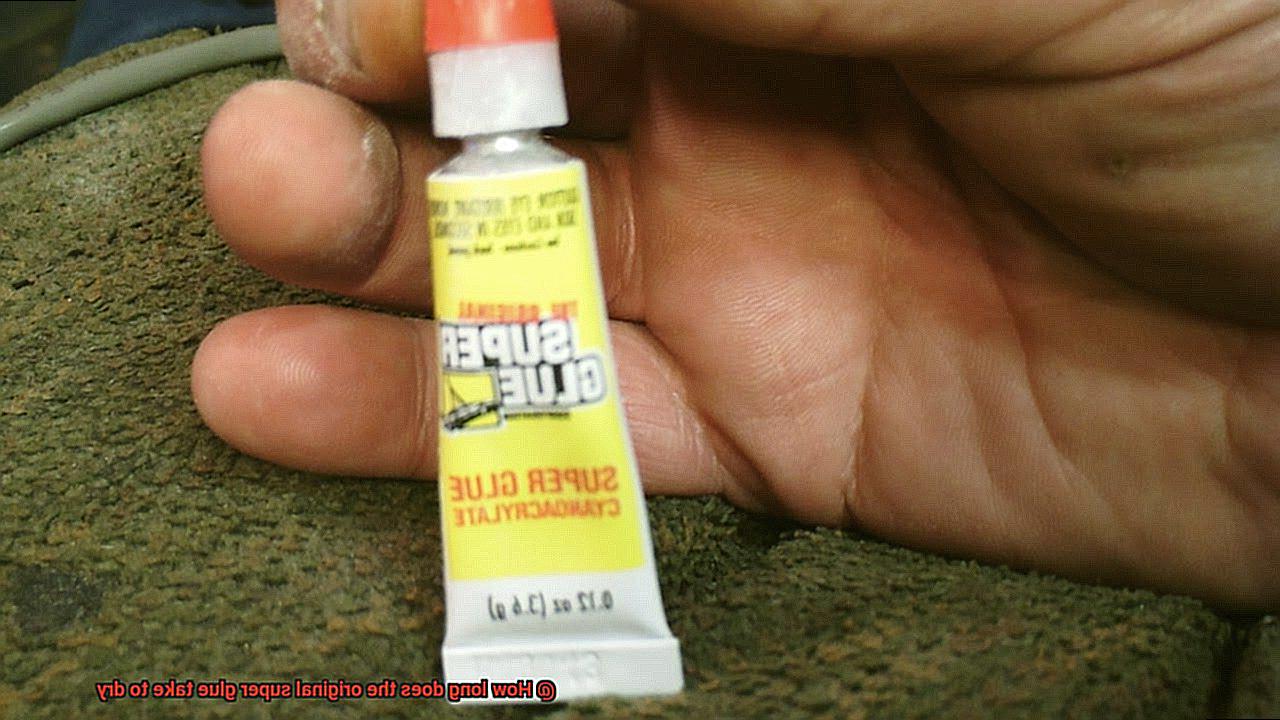
Super glue, also known as cyanoacrylate adhesive, is a fast-drying adhesive that forms a strong bond between surfaces. The average drying time of original super glue ranges from 10 to 30 seconds, making it a quick and efficient option for various projects.
However, several factors can influence the drying time of super glue. Firstly, the type or brand of super glue being used can affect the drying time. Different brands may have slightly different formulations, resulting in variations in drying times. Some brands even offer quick-drying formulas that can bond surfaces in mere seconds, providing an impressive display of speedy stickiness.
The type of materials being bonded also plays a role in drying time. It is crucial to ensure that the surfaces are clean and dry before applying super glue. Any moisture or contaminants on the surfaces can impact both the drying time and the strength of the bond. To prepare the surfaces adequately, use a clean cloth to wipe away any dirt or grease, ensuring optimal adhesion.
Environmental factors such as temperature and humidity can significantly influence drying time. Higher temperatures tend to speed up the curing process, while lower temperatures can slow it down. Similarly, low humidity levels can prolong drying time, while high humidity can expedite it. Monitoring these factors and adjusting accordingly will help achieve desired results.
While super glue typically cures within a few minutes after application, it may take up to 24 hours for the bond to reach its maximum strength. During this curing process, the super glue undergoes a chemical reaction with moisture in the air to form a solid and durable bond. Patience is key, as allowing sufficient time for the glue to work its magic ensures a reliable and long-lasting adhesion.
To achieve the best results with super glue, it is essential to carefully follow the instructions provided by the manufacturer. These instructions often include recommended drying times and any precautions or special considerations for specific materials. By adhering to these instructions, users can optimize the bonding process and achieve strong, reliable bonds.
Lastly, for those seeking not only strength but also aesthetics, some brands offer colored variations of super glue for specific applications. These colored super glues can be advantageous when working with materials that require a more discreet or visually appealing bond. So, whether you want to blend in or add a pop of color, exploring these options can enhance the overall outcome of your project.
Preparing the Surfaces for Glue Application
We’re about to take a deep dive into the nitty-gritty details. Trust me, this step is crucial if you want a bond that’s as strong as steel and as durable as a diamond. So roll up your sleeves, grab your cleaning supplies, and let’s get started.
First things first, cleanliness is key. Imagine trying to stick glue onto a dirty surface – it’s like trying to build a sandcastle on quicksand. So grab some mild detergent or rubbing alcohol and give those surfaces a good scrub. Get rid of any dirt, dust, grease, or debris that could hinder the adhesive’s ability to work its magic.
But hold on tight, because we’re not done yet. Next up, we’re going to roughen those surfaces. Super glue loves a little texture – it’s like giving it tiny hooks to latch onto. So grab some fine-grit sandpaper or a file and gently sand or scrape the surfaces. We’re not talking about a full-on makeover here, just enough roughness to make the bond stronger than ever.
Oh, and if you’ve got any fancy coatings on those surfaces – like paint or varnish – it’s time to strip them away. Those coatings can be real party poopers when it comes to bonding. But don’t worry, we’ve got the solution. Use appropriate stripping agents or sanding techniques to expose the bare surface underneath. It’s like peeling off layers to reveal the hidden strength beneath.
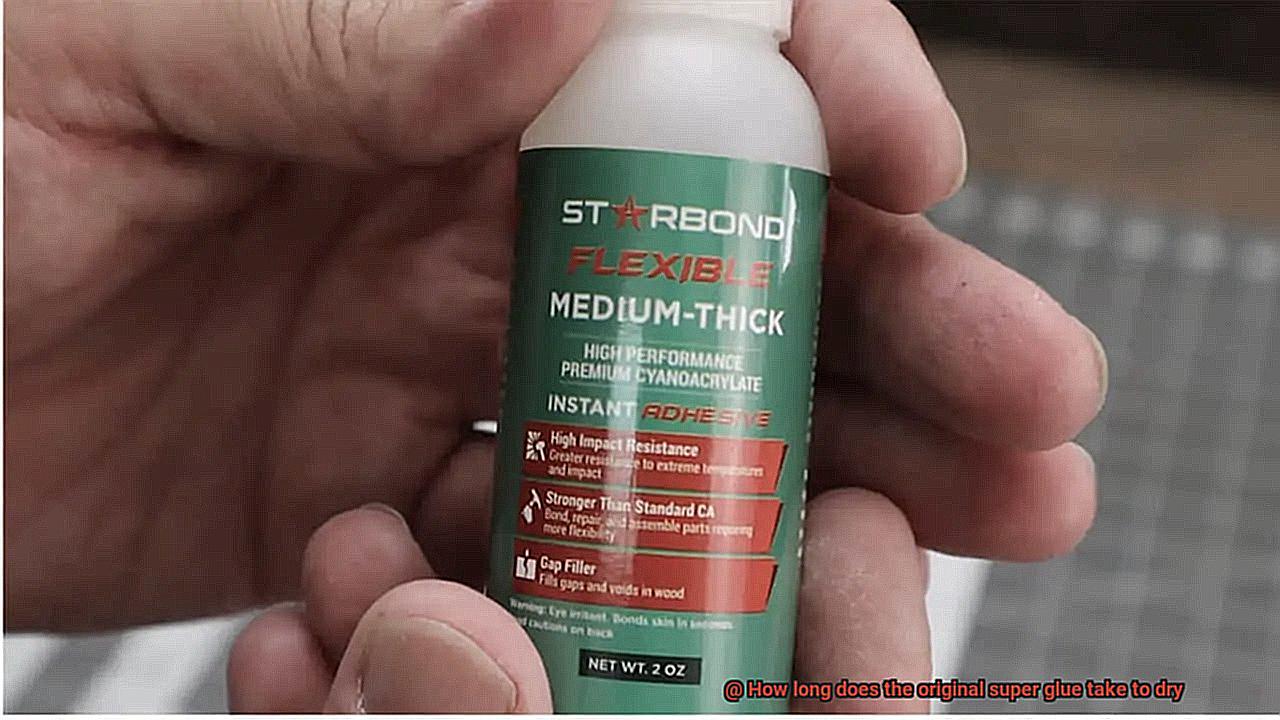
Now here’s a secret tip for you: some materials love a little primer action before gluing. Wood and fabric are prime candidates for this extra step. A primer helps seal and prepare the surface for better adhesive penetration. It’s like giving your glue a little boost, ensuring that it bonds with unparalleled strength.
And lastly, my friends, we must test compatibility. I know, I know, you’re eager to dive into the gluing process, but trust me, you don’t want any surprises later on. Apply a small amount of glue on a less visible area and observe how it interacts with the material. Look out for discoloration or any other negative effects. It’s better to be safe than sorry – so take the time to test before committing to the bond.
Temperature and Humidity Effects on Drying Time
Today, we embark on a scientific journey into the captivating world of super glue, exploring how temperature and humidity can work their magic (or mischief) on its drying time. So don your lab coats, as we delve into the intricate dance between these two factors.
Temperature: The Heat Wave
Temperature, the catalyst that sets things in motion, holds immense power over super glue’s drying time. With higher temperatures, it’s like a shot of espresso for the glue’s molecules; they become vivacious and lively, bonding faster than you can utter “super glue.” However, in the midst of a wintry chill, brace yourself for a slow dance. The molecules move sluggishly, taking their sweet time to bond.
Humidity: The Moisture Meddler
Now, let’s turn our attention to humidity. Imagine trying to bond two surfaces with super glue while battling against air as humid as a tropical rainforest. Moisture in the air proves to be a real buzzkill for our glue friends. It gleefully interferes with the bonding process, playing hard to get. So, if you find yourself dealing with high humidity levels, expect a longer drying time.
On the flip side, low humidity levels act as an adrenaline rush for super glue. With less moisture in the air, it can focus solely on its bonding mission. It’s akin to unleashing a cheetah on a race track – lightning-fast drying time.
The Sweet Spot: Ideal Conditions
For most super glues, cozy conditions are key to optimal drying time. Picture room temperature (around 20-25 degrees Celsius or 68-77 degrees Fahrenheit) with moderate humidity levels (around 40-60%). This magical combination propels our glue buddies towards peak efficiency when it comes to drying.
Remember, different types of super glue may have specific temperature and humidity requirements for optimal performance. Always consult the manufacturer’s instructions to ensure you’re on the right track.
Beyond Drying: The Marvels of Curing
Appearances can deceive. Even if your super glue seems dry on the surface, it hasn’t completed its journey to full strength. Curing is the process where the glue hardens and achieves its maximum potency. So, even if it appears sturdy, grant it some extra time to fully cure before subjecting it to the ultimate test.
Other Factors at Play
Before we conclude this enlightening expedition, let’s not overlook a few other factors that influence drying and curing times. The thickness of application, type of material being bonded, and ventilation all play pivotal roles in your glue’s path towards perfection. Keep these variables in mind for a seamless bonding experience.
Applying the Right Amount of Super Glue
Today, we embark on a journey into the art of applying the perfect amount of super glue for a strong bond. Whether you’re a DIY enthusiast or a seasoned pro, mastering the technique of applying the right amount of glue is crucial for a successful project. So, grab your precision applicator and let’s dive in.
Preparation is key before applying the glue. To ensure a strong bond, it’s essential to clean and prepare the surfaces to be bonded. Dust, dirt, and oil can hinder the adhesive properties of the glue, so wipe them down with a clean cloth or use a mild detergent if necessary. Remember, a clean surface sets the stage for a sturdy bond.
Now, let’s talk about how much super glue to use. The recommended amount depends on the size and type of materials you are bonding. For small or delicate items, a tiny drop or two is usually sufficient. You want enough glue to create a strong bond but not so much that it creates a mess or takes longer to dry. For larger or heavier objects, you may need to use a slightly larger amount, but always use it sparingly.
To ensure you have the right amount of glue, it’s always a good idea to do a test on a small area before applying it to the entire surface. This will help you determine if you need more or less glue for a secure bond.
Now, let’s get down to business – application. Using a precision applicator or a small brush is best for controlling the amount of glue you apply. This allows for more precise application and avoids excessive spreading of the glue. Remember, less is often more when it comes to super glue.
When joining the surfaces together, apply gentle pressure. It’s important not to apply too much pressure as this can cause excess glue to squeeze out, resulting in messiness and longer drying time. A firm but gentle touch is all you need for a strong bond.
After applying the right amount of glue, hold the bonded pieces together firmly for a few seconds. This ensures proper adhesion and prevents any movement that could disrupt the bonding process. Now, here comes the waiting game.
The drying time of super glue varies based on several factors such as humidity, temperature, and the type of materials being bonded. Generally, super glue dries within seconds to a few minutes on the surface. However, it’s important to note that even though it may appear dry, the bond may take longer to fully cure and reach its maximum strength. We recommend waiting at least 24 hours before subjecting the bonded item to stress or heavy use.
Holding the Bonded Surfaces Firmly Together
Holding the bonded surfaces firmly together during the drying process is the secret. Whether you’re a DIY enthusiast or simply curious about the science of glue, read on to discover why proper surface bonding is crucial when using super glue and learn key techniques for success.
The Need for a Secure Bond:
Creating a strong and secure bond requires holding the bonded surfaces firmly together until the glue dries. This prevents any movement or shifting that could weaken the bond over time, ensuring that the materials stay in place.
Factors Affecting Drying Time:
The drying time of super glue varies based on several factors, including the type of material, glue amount, and environmental conditions. However, super glue sets quickly compared to other adhesives, forming a strong bond within minutes.
Techniques for Holding Surfaces Together:
To achieve a successful bond, various techniques can be employed to hold surfaces together securely without damaging them:
- Clamps or tape: Apply pressure using clamps or tape, ensuring not to exert excessive force that may compromise material integrity.
- Applying pressure with your hands: For smaller or delicate objects, apply pressure using your hands while avoiding direct contact with the glue to prevent skin irritation. Use gloves or tools like toothpicks or popsicle sticks for safe application.
Tailoring Techniques to Different Materials:
Different materials require specific techniques for secure bonding:
- Flat surfaces: Use clamps or place a heavy object on top.
- Vertical or irregular surfaces: Employ creative solutions such as temporary supports or braces.
Accelerators and Activators:
Some super glue formulations include accelerators or activators that speed up drying. Apply these products to one or both surfaces before bonding for faster curing times and a quicker bond.
Curing Process of Super Glue
Today, we embark on an exciting journey into the mesmerizing world of super glue and uncover the secrets behind its curing process. Have you ever marveled at how this magical liquid transforms into a solid bond in mere seconds? Prepare to be captivated as we delve deep into the art of super glue.
The Marvelous Curing Process:
When super glue meets the air, it undergoes a dazzling chemical reaction called polymerization. Picture this: individual adhesive molecules joining hands and elegantly moving together to form long chains of polymer. It’s like a dance party where the magic happens as they intertwine and create a solid bond.

The Influence of Environmental Conditions:
Now, let’s explore how our surroundings impact the drying time of super glue. Temperature, humidity, and even the thickness of the adhesive layer all play key roles in this adhesive ballet.
Temperature Tango:
Temperature holds immense power over the curing process. Higher temperatures bring the heat, accelerating the reaction and resulting in faster drying times. Conversely, colder temperatures put on the brakes, slowing down the reaction and extending drying time. So, for optimal performance, let super glue show off its moves at room temperature.
Humidity Waltz:
Humidity takes center stage with its unique moves. Super glue craves moisture from the air to initiate and complete the polymerization reaction. High humidity levels become energetic partners that quicken the dance, while low humidity levels gently prolong the drying process like a slow dance. To speed things up in a low humidity environment, consider using a humidifier or give surfaces a delicate mist.
Thickness Tango:
Remember, in the world of super glue, thin is in. Thicker layers take longer to dry compared to thin layers. Embrace the art of precision and skillfully apply a thin and even layer of super glue for faster curing.
The Formulation Factor:
Different formulations of super glue exist, each with its own curing time. Some variants are designed to dry even faster, while others cater to flexible bonds that may require slightly longer curing times. Always consult the manufacturer’s instructions to choose the perfect super glue for your needs.
Accidental Contact with Skin or Eyes
Accidents happen, even to the most careful of us. When it comes to super glue, accidental contact with skin or eyes can be a real sticky situation. But fear not. In this blog post, we’ll guide you through the steps to take if you find yourself in this predicament. So, grab your protective gear and let’s dive into the world of super glue remedies.
Prevention is key:
Before we jump into the solution, let’s talk prevention. Wearing protective gloves and goggles when using super glue is a smart move. It keeps your skin and eyes safe from potential mishaps. Also, working in a well-ventilated area helps prevent inhaling any fumes. Remember, it’s always better to be safe than sorry.
Removing super glue from skin:
If you accidentally get super glue on your skin, don’t panic. Start by washing the affected area with warm soapy water. Gently scrubbing the glue with a soft cloth or sponge may help loosen its grip. Avoid using harsh chemicals or abrasive materials as they can irritate the skin further.
In case the glue is stubbornly clinging to your fingers or other body parts, try using acetone or nail polish remover. Soak a cotton ball or swab in acetone and apply it to the glued area for a few minutes. This should help dissolve the adhesive and make it easier to peel off or gently rub away. Remember to moisturize your skin after removal since acetone can be drying.
Dealing with super glue in the eyes:
Accidental contact with super glue in the eyes requires immediate action. If this happens to you, resist the urge to rub or blink excessively, as it can worsen the situation. Instead, rinse your eye with water for at least 15 minutes. You can use a cup or clean hands to pour water into your eye while keeping it open. If the irritation persists or discomfort continues, seek medical attention right away.
Aonikb1CPOU” >
Conclusion
The drying time of original super glue can be crucial when you’re in a rush to complete a project or fix something quickly. Fortunately, this powerful adhesive doesn’t keep you waiting for long. In fact, within mere seconds, you’ll witness the magic of super glue as it begins to set and bond materials together.
But don’t let its speedy nature fool you; this adhesive is not one to compromise on strength. Once fully dried, which typically takes around 24 hours, the bond created by original super glue is incredibly robust and durable.
So whether you’re repairing broken ceramics, fixing jewelry, or tackling DIY projects around the house, rest assured that with original super glue, you won’t have to twiddle your thumbs waiting for ages. Its rapid drying time ensures that your creations are back in action swiftly and securely.
In conclusion, original super glue dries in seconds and reaches its full strength within 24 hours.

